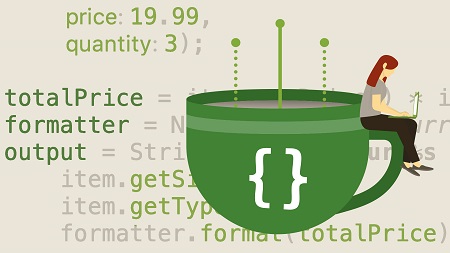
English | MP4 | AVC 1280×720 | AAC 48KHz 2ch | 3h 43m | 526 MB
If you want to build applications for mobile devices, desktop computers, or the web, you need to know Java. This course provides the foundation for learning how to program with the most recent Long-Term Support (LTS) release, Java SE 11, and more recent versions. David Gassner shows how to install Java and the IntelliJ IDEA Community Edition IDE and start working with variables, data types, and other critical language components. He also helps you control program flow with conditional logic and loops, store data with Java collections, and understand how Java implements object-oriented coding principles such as inheritance.
Topics include:
- The history and principles of Java
- Installing the JDK and IntelliJ IDEA
- Working with variables and values
- Working with object data types
- Building, comparing, and parsing strings
- Debugging and exception handling
- Creating loops and reusable code
- Passing arguments by reference or value
- Creating custom classes
- Working with inheritance
- Managing data collections
Table of Contents
1 What kind of software can you create
2 What you need to know
3 Explore the history of Java
4 Principles and components of Java
5 Explore basic Java syntax
6 Memory management and garbage collection
7 Choose a development environment
8 Install the JDK on Windows
9 Install the JDK on macOS
10 Install and configure IntelliJ IDEA
11 Test simple Java code in JShell
12 Compile Java code to bytecode
13 Pass arguments to a console application
14 Use the Java API documentation
15 Work with primitive variables
16 Declare and modify primitive values
17 Declare and initialize object variables
18 Manage currency values with BigDecimal
19 Convert values between numeric types
20 Math operators and the Math class
21 Manage true and false Boolean values
22 Manage character values as primitives
23 More about Java operators
24 Declare and initialize string values
25 Build a string from multiple values
26 Clone the exercise files from GitHub
27 Convert primitive values to strings
28 Format numeric values as strings
29 Interpolate strings with placeholders
30 Compare string values
31 Parse string values
32 Get string values from user input
33 Challenge A simple calculator
34 Solution A simple calculator
35 Evaluate conditions with if-else
36 Evaluate conditions with switch-case
37 Create looping code blocks
38 Create reusable code with methods
39 Create overloaded methods
40 Pass arguments by reference vs. value
41 Debug with IntelliJ IDEA
42 Handle exceptions with try catch
43 Create multiple catch blocks
44 Close objects with try-with-resources
45 Challenge A more complex calculator
46 Solution A more complex calculator
47 Declare and use custom classes
48 Organize code with packages
49 Create instance fields and methods
50 Declare multiple constructor methods
51 Use static fields as constants
52 Declare and use Enum types
53 About inheritance
54 Extend classes and override methods
55 Use objects as their super types
56 Store values in simple arrays
57 Manage resizable arrays with Lists
58 Manage key-value pairs with Maps
59 Next steps
Resolve the captcha to access the links!